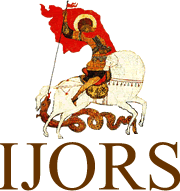
ISSN: 2158-7051
====================
INTERNATIONAL JOURNAL OF
RUSSIAN STUDIES
====================
ISSUE NO. 12 ( 2023/2 )
 |
ISSN: 2158-7051 ==================== INTERNATIONAL JOURNAL OF RUSSIAN STUDIES ==================== ISSUE NO. 12 ( 2023/2 ) |
SOVIET THEATRE DURİNG THE THAW, By Ayse Dietrich*, Published by: Methuen Drama. Bloomsbury Publishing Plc, Written by Jesse Gardiner,
Year of Publishing: 2022. Subject Area: Soviet Union, Theater, Thaw period, Book Type: Russian History and Culture. Total Number of
Pages: 215. ISBN: 9781350150621, hardback, $110,00.
This book is about Moscow’s two main theater squares, their common features and the unification
of traditional theater with alternative and divergent forms of performance, and
the sites and spaces where these cultures meet and the outcomes that arise when
standard norms and hierarchies are disrupted. The author examines Soviet
theater during the disruptive Stalinist period,
the persecution of the avant-garde and cultural figures, and re-emergence of
avant-garde style, forms and techniques on the stage after Stalin’s death in
1953 and during the Thaw period.
The
book is composed of an introduction and six chapters. In the Introduction
Gardiner talks about Moscow’s main Theater Square where some of the most prestigious and distinguished academic theaters are
located. She describes the second theater square, Triumfal’naia Square as the center of a counter-history of
the less illustrious theatrical genres. The author also talks about the
disruptive period of the Soviet theater and avant-garde during Stalin and the
revival of avant-garde theater during the Thaw period (1953–1964) and how the disruptive process influenced,
and was in turn influenced by, the broader societal processes of
de-Stalinization.
In
the first chapter, the author examines the Soviet theater during Stalin and the persecution of the avant-garde and cultural figures, the troubled fall of
avant-garde directors such as Meyerhold and Tairov,
the purging of writers and the closure of theaters. This chapter also discusses
the development of the official method of socialist realism and asks what it meant
for the theater in terms of playwriting, acting and stage setting.
In the second chapter,
the author examines the turbulent years of the Thaw and explores the brief but
influential term of Nikolai Akimov as artistic
director of the Lensovet Theater in Leningrad from
1952 to 1955, his creative solutions in stage settings despite the Soviet
bureaucratic system and lawless police state, his breaking with the norms of
Soviet theater established during Stalinism by combining a psychologically
realist approach. She also explains how Akimov’s three
plays on the Russian state system Shadows, The Case and The
Government Inspector changed the outlook of Soviet theater during the early
stages of the Thaw.
In the
third chapter, the author emphasizes the importance of the restaging of Mayakovsky’s three major plays for the first time written
specifically for Meyerhold’s theater. She states that
by restaging Mayakovsky and remembering Meyerhold,
these productions eliminated many of the standard norms of the Soviet theater
that were imposed during Stalin. She argues that directors such
as Valentin Pluchek and Sergei Iutkevich
redefined the framework of socialist realism by including wide range of styles.
In chapter
four, the author concentrates on Vsevolod Vishnevskii’s An
Optimistic Tragedy staged at the Aleksandrinskii Theater
in Leningrad and Nikolai Pogodin’s Aristocrats staged
at the Mayakovsky Theater in Moscow during the de-Stalinization
period and states that by using a wide range of stylized patterns and
techniques these prototypical socialist realist plays changed the narrow
understanding of socialist realism of the Stalinist era.
In the fifth chapter the
author focuses on the Moscow Art Theater (MAT) that was directly linked to the
party, and the Sovremennik Theater-Studio in Moscow
founded during the Thaw period that restored the values of integrity and
authenticity produced by Stanislavsky and Nemirovich-Danchenko
and staged a new wave of plays written by the new vanguard of Soviet dramatists
like Viktor Rozov, Anatolii
Kuznetsov and Aleksandr Volodin who focused on themes
of moral sincerity and integrity, rather than party ideology replacing socialist
realism with neorealism, a new term borrowed from Italian cinema.
In chapter
six, the author states describes the end of the Thaw
period as “an uncertain period in which the party’s approach to culture was
inconsistent and contested, when relations between editors and writers,
artistic councils and directors, theaters and audiences were complex,
unpredictable”, however, it was a transition period that brought the opportunity
to present new plays as well as the works of dramatists that had been
previously banned.
The book Soviet
Theatre during the Thaw is a well-written book that provides important
information about the Soviet theater during the transitional Thaw period and discusses the old and new methods and
themes used by the directors and playwrights. It
constitutes
a valuable source for those interested in studying the Russian theater during Khrushchev.
*Ayse Dietrich - Professor, Part-time, at Middle East Technical University, Department of History and Eurasian Studies. Editor and the founder of the International Journal of Russian Studies (IJORS) e-mail: editor@ijors.net, dayse@metu.edu.tr, dietrichayse@yahoo.com
© 2010, IJORS - INTERNATIONAL JOURNAL OF RUSSIAN STUDIES